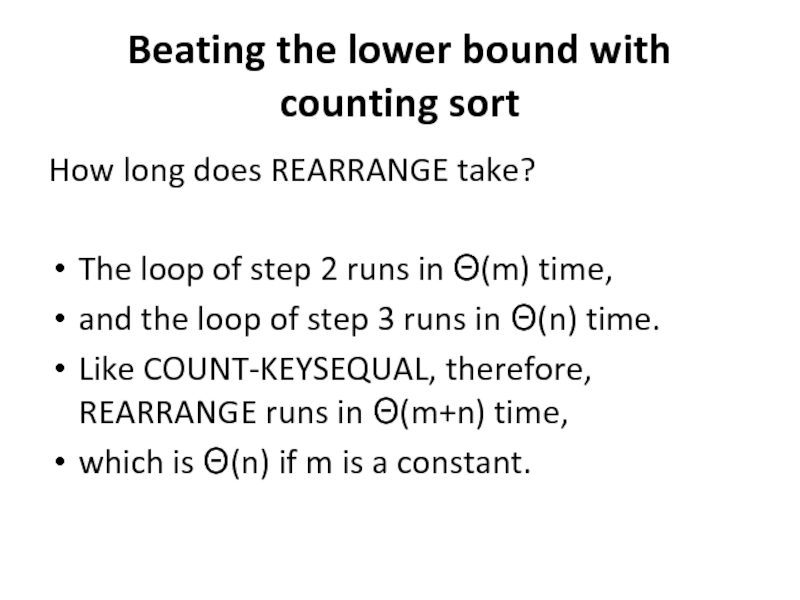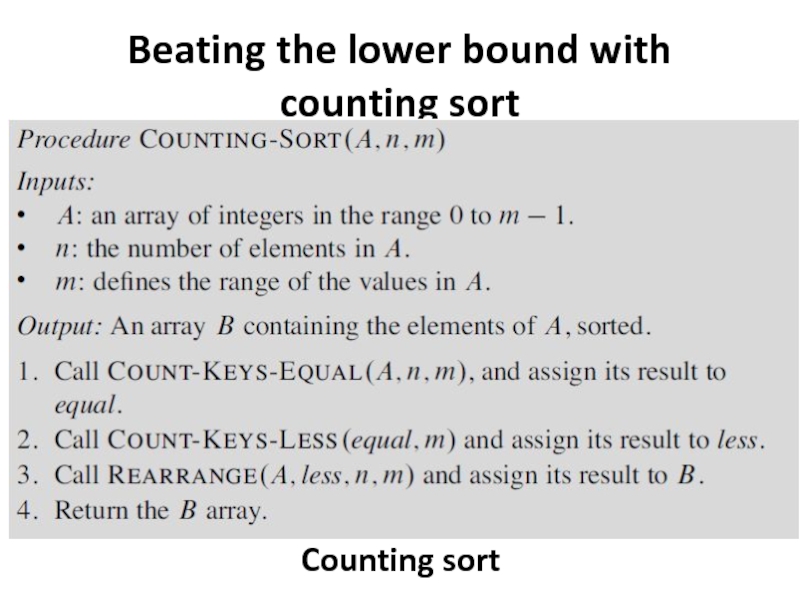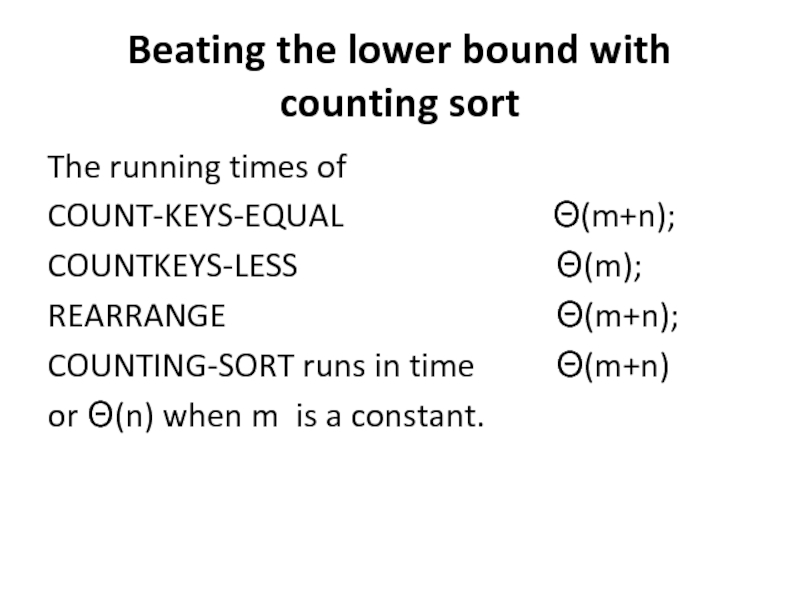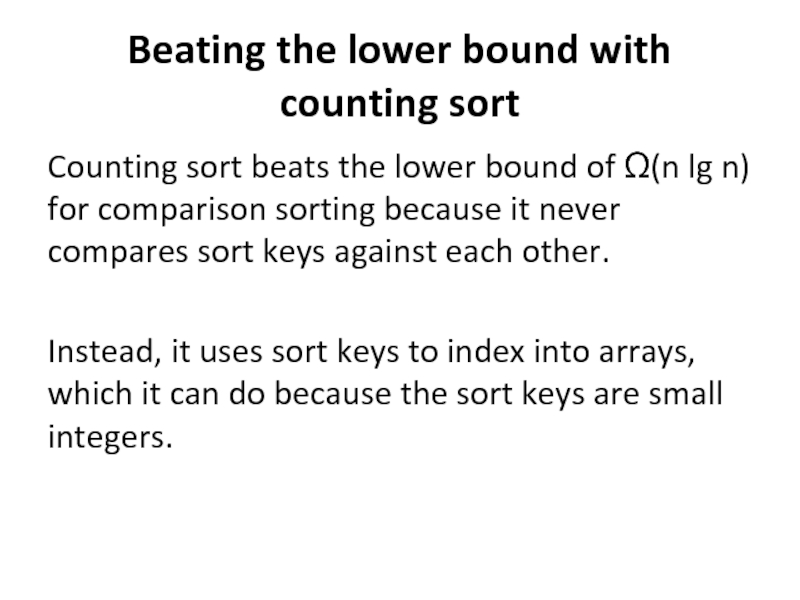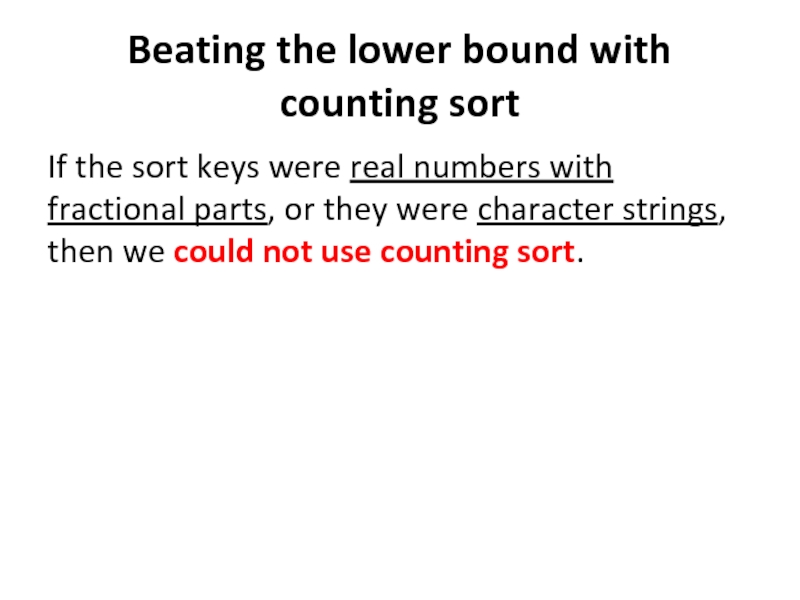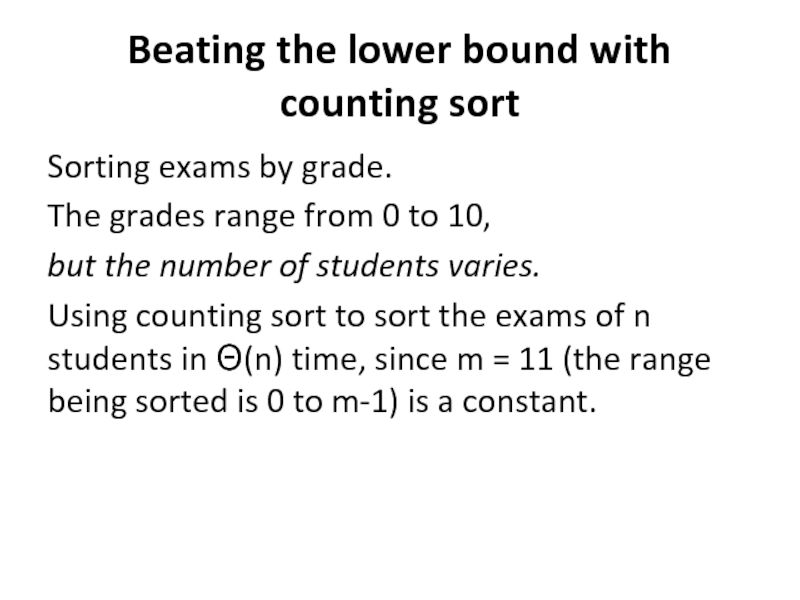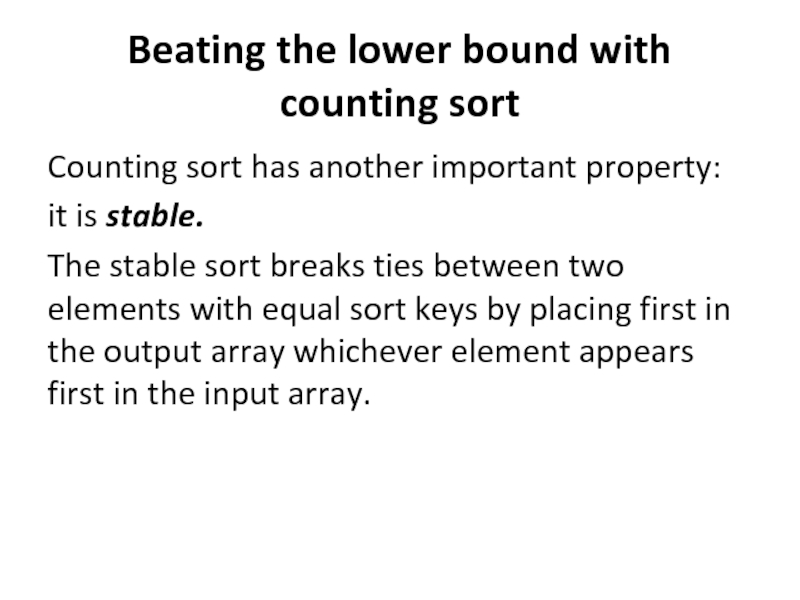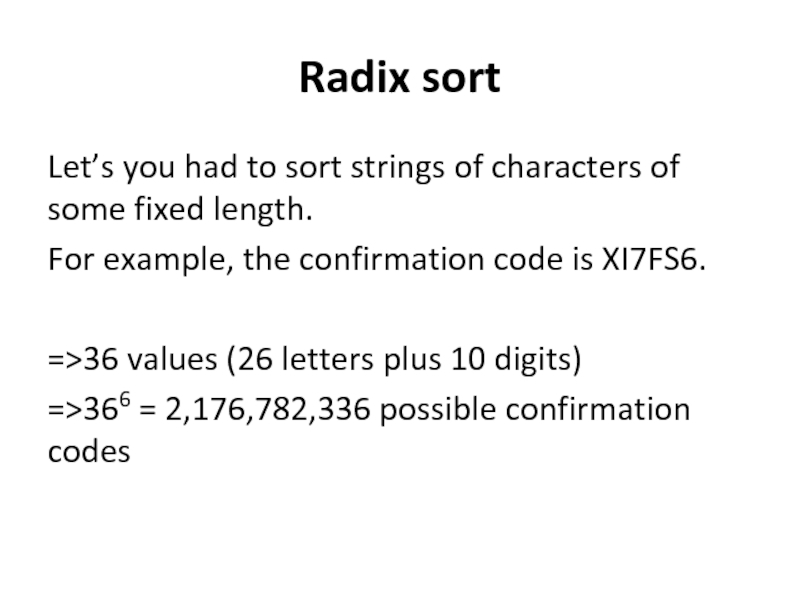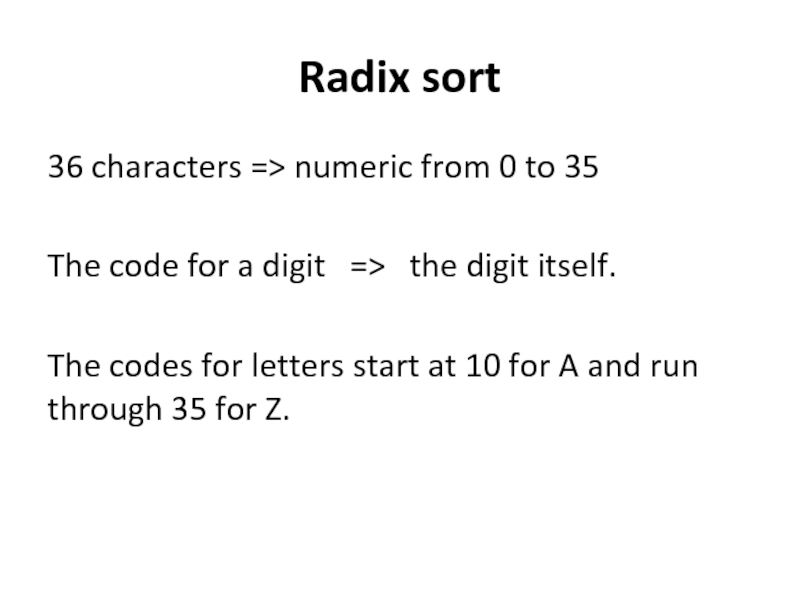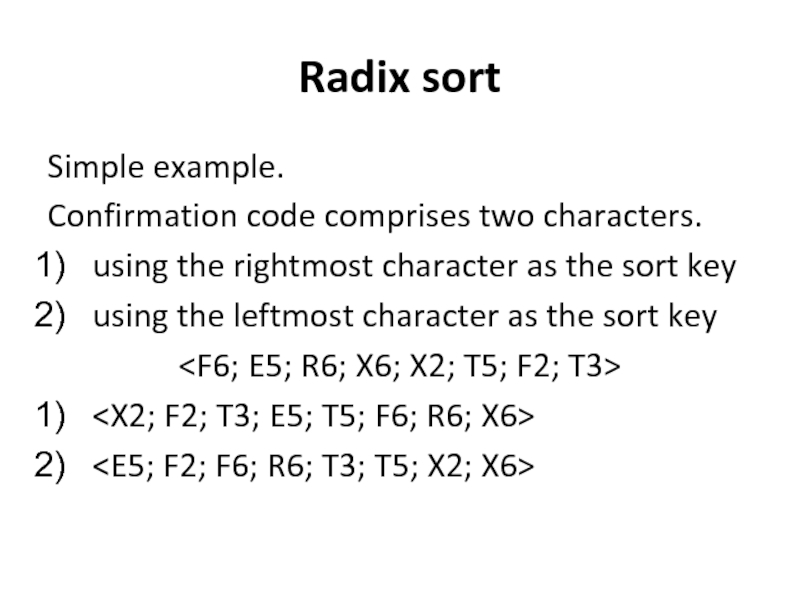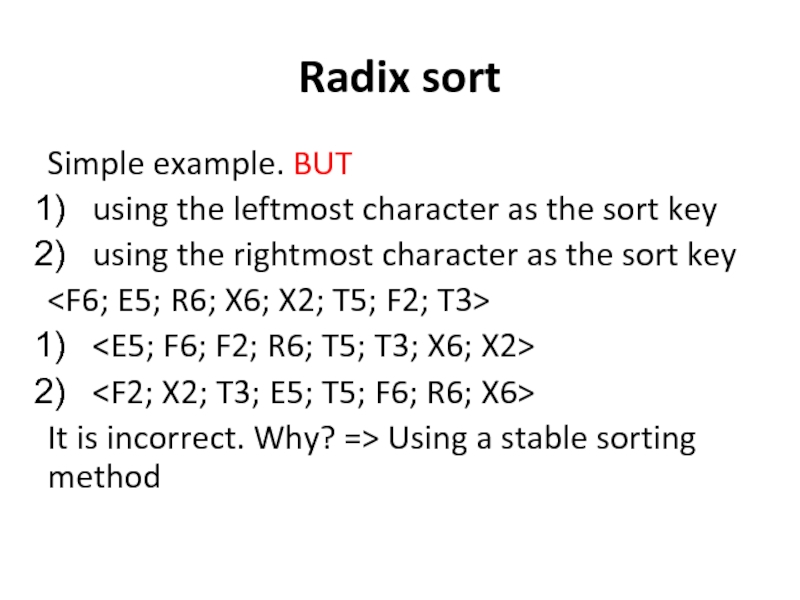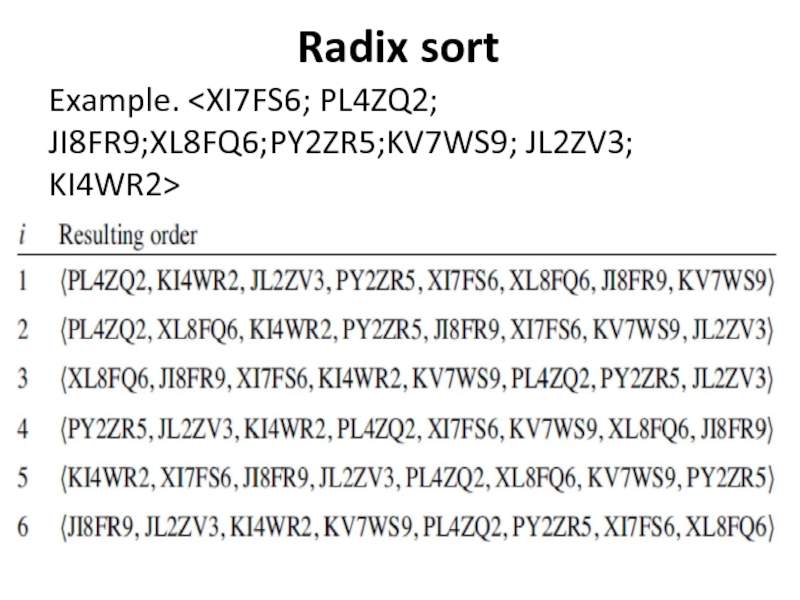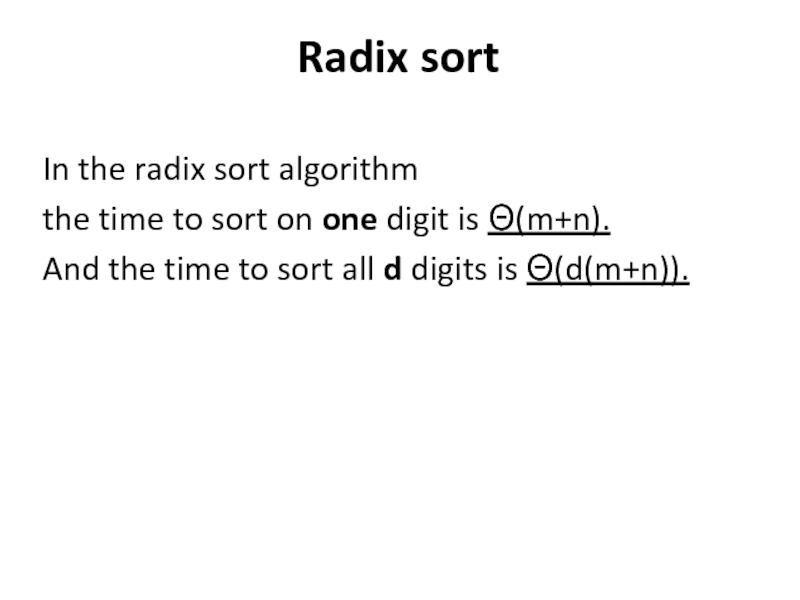- Главная
- Разное
- Дизайн
- Бизнес и предпринимательство
- Аналитика
- Образование
- Развлечения
- Красота и здоровье
- Финансы
- Государство
- Путешествия
- Спорт
- Недвижимость
- Армия
- Графика
- Культурология
- Еда и кулинария
- Лингвистика
- Английский язык
- Астрономия
- Алгебра
- Биология
- География
- Детские презентации
- Информатика
- История
- Литература
- Маркетинг
- Математика
- Медицина
- Менеджмент
- Музыка
- МХК
- Немецкий язык
- ОБЖ
- Обществознание
- Окружающий мир
- Педагогика
- Русский язык
- Технология
- Физика
- Философия
- Химия
- Шаблоны, картинки для презентаций
- Экология
- Экономика
- Юриспруденция
Beating the lower bound with counting sort презентация
Содержание
- 1. Beating the lower bound with counting sort
- 2. A Lower Bound for Sorting Rules for
- 3. “if this element’s sort key is less
- 4. 1) each sort key is either 1
- 5. =>go through every element and count how
- 6. Rules for sorting
- 7. The lower bound on comparison sorting A
- 8. The lower bound on comparison sorting This
- 9. The lower bound on comparison sorting We
- 10. The lower bound on comparison sorting 1)
- 11. The lower bound on comparison sorting A
- 12. The lower bound on comparison sorting 2)
- 13. Beating the lower bound with counting sort Procedure REALLY-SIMPLE-SORT
- 14. Beating the lower bound with counting sort Procedure COUNT-KEYS-EQUAL
- 15. Beating the lower bound with counting
- 16. Beating the lower bound with counting
- 17. Beating the lower bound with counting
- 18. Beating the lower bound with counting sort
- 19. Beating the lower bound with counting
- 20. Beating the lower bound with counting
- 21. Beating the lower bound with counting sort
- 22. Beating the lower bound with counting
- 23. Beating the lower bound with counting
- 24. Beating the lower bound with counting
- 26. Example.
- 30. Beating the lower bound with counting
- 31. Beating the lower bound with counting
- 32. Beating the lower bound with counting
- 33. Beating the lower bound with counting
- 34. Beating the lower bound with counting sort Counting sort
- 35. Beating the lower bound with counting
- 36. Beating the lower bound with counting
- 37. Beating the lower bound with counting
- 38. Beating the lower bound with counting
- 39. Beating the lower bound with counting
- 40. Beating the lower bound with counting
- 41. Radix sort Let’s you had to sort
- 42. Radix sort 36 characters => numeric from
- 43. Radix sort Simple example. Confirmation code comprises
- 44. Radix sort Simple example. BUT using the
- 45. Radix sort Example.
- 46. Radix sort In the radix sort algorithm
Слайд 2A Lower Bound for Sorting
Rules for sorting.
The lower bound on comparison
sorting.
Beating the lower bound with counting sort.
Radix sort.
Beating the lower bound with counting sort.
Radix sort.
Слайд 3“if this element’s sort key is less than this
other element’s
sort key, then do something,
and otherwise either do something else or
do nothing else.”
and otherwise either do something else or
do nothing else.”
Rules for sorting
Does a sorting algorithm use only this form?
No.
Слайд 41) each sort key is either 1 or 2,
2) the
elements consist of only sort keys.
In this simple situation, we can sort n elements
in only Θ(n) time.
In this simple situation, we can sort n elements
in only Θ(n) time.
Rules for sorting
Слайд 5=>go through every element and count how many
of them are
1s;
let’s say that k elements have the value 1.
=>go through the array, filling the value 1 into
the first k positions and then filling the value 2
into the last n - k positions.
let’s say that k elements have the value 1.
=>go through the array, filling the value 1 into
the first k positions and then filling the value 2
into the last n - k positions.
Rules for sorting
Слайд 7The lower bound on comparison sorting
A comparison sort is any sorting
algorithm that determines the sorted order only by comparing pairs of elements.
The four sorting algorithms from the previous lecture are comparison sorts (but REALLY-SIMPLE-SORT is not).
The four sorting algorithms from the previous lecture are comparison sorts (but REALLY-SIMPLE-SORT is not).
Слайд 8The lower bound on comparison sorting
This is the lower bound:
In
the worst case, any comparison sorting algorithm for n elements requires Ω(n lg n) comparisons between pairs of elements.
What is Ω-notation?
What is Ω-notation?
Слайд 9The lower bound on comparison sorting
We write: Ω-notation (It gives a
lower bound)
We say: “for sufficiently large n, any comparison sorting algorithm requires at least (cnlg n) comparisons in the worst case, for some constant c”.
We say: “for sufficiently large n, any comparison sorting algorithm requires at least (cnlg n) comparisons in the worst case, for some constant c”.
Слайд 10The lower bound on comparison sorting
1) Lower bound is saying something
only about the worst case; the best case may be Θ(n) time.
In the worst case Ω(n lg n) comparisons are necessary.
It is an existential lower bound.
In the worst case Ω(n lg n) comparisons are necessary.
It is an existential lower bound.
Слайд 11The lower bound on comparison sorting
A universal lower bound => applies
to all inputs.
For sorting the only universal lower bound is Ω(n).
For sorting the only universal lower bound is Ω(n).
Слайд 12The lower bound on comparison sorting
2) The lower bound does not
depend on the particular algorithm, as long as it’s a comparison sorting algorithm.
The lower bound applies to every comparison sorting algorithm, no matter how simple or complex.
The lower bound applies to every comparison sorting algorithm, no matter how simple or complex.
Слайд 15Beating the lower bound with
counting sort
Example. Let’s we know that
the sort keys are integers in the range 0 to m-1.
And let’s we know:
three elements have sort keys equal to 5;
six elements have sort keys less than 5 (that is, in the range 0 to 4).
Then in the sorted array the elements with sort keys equal to 5 should occupy positions 7, 8, 9.
And let’s we know:
three elements have sort keys equal to 5;
six elements have sort keys less than 5 (that is, in the range 0 to 4).
Then in the sorted array the elements with sort keys equal to 5 should occupy positions 7, 8, 9.
Слайд 16Beating the lower bound with
counting sort
Generalize.
If k elements have sort
keys equal to x and that l elements have sort keys less than x, then the elements with sort keys equal to x should occupy positions l+1 through l+k in the sorted array.
Слайд 17Beating the lower bound with
counting sort
What should be done?
We
want to compute, for each possible sort-key value,
1) how many elements have sort keys less than that value and
2) how many elements have sort keys equal to that value.
1) how many elements have sort keys less than that value and
2) how many elements have sort keys equal to that value.
Слайд 18Beating the lower bound with counting sort
Computing: how many elements have
sort keys equal to that value.
Слайд 19Beating the lower bound with
counting sort
Notice that COUNT-KEYS-EQUAL never compares
sort keys with each other.
It uses sort keys only to index into the equal array.
It uses sort keys only to index into the equal array.
Слайд 20Beating the lower bound with
counting sort
Since the first loop (step
2) makes m iterations, the second loop (step 3) makes n iterations, and each iteration of each loop takes constant time, COUNT-KEYS-EQUAL takes Θ(m+n) time.
If m is a constant, then COUNT-KEYS-EQUAL takes Θ(n) time.
If m is a constant, then COUNT-KEYS-EQUAL takes Θ(n) time.
Слайд 21Beating the lower bound with counting sort
Computing: how many elements have
sort keys less than each value.
Слайд 22Beating the lower bound with
counting sort
Example.
Suppose that m = 7,
so that all sort keys are integers in the range 0 to 6.
Array A with n = 10 elements:
A = (4; 1; 5; 0; 1; 6; 5; 1; 5; 3).
Array A with n = 10 elements:
A = (4; 1; 5; 0; 1; 6; 5; 1; 5; 3).
Слайд 23Beating the lower bound with
counting sort
Then equal = (1; 3;
0; 1; 1; 3; 1)
A = (4; 1; 5; 0; 1; 6; 5; 1; 5; 3)
Because
How many elements in the array A equal to 0? => 1 => then equal[0]=1
How many elements in the array A equal to 1? => 3 => then equal[1]=3
How many elements in the array A equal to 2? => 0 => then equal[2]=0
A = (4; 1; 5; 0; 1; 6; 5; 1; 5; 3)
Because
How many elements in the array A equal to 0? => 1 => then equal[0]=1
How many elements in the array A equal to 1? => 3 => then equal[1]=3
How many elements in the array A equal to 2? => 0 => then equal[2]=0
Слайд 24Beating the lower bound with
counting sort
less = (0; 1; 4;
4; 5; 6; 9)equal = (1; 3; 0; 1; 1; 3; 1)
Because
less[0]= 0
less[1]= equal [0] = 1
less[2]= equal [0] + equal [1] =1 + 3 = 4
less[3]= equal [0] + equal [1] + equal [2] = 1 + +3 + 0 = 4
less[4]= equal [0] + equal [1] + equal [2] + +equal [3] = 1 + 3 + 0 + 1 = 5
Because
less[0]= 0
less[1]= equal [0] = 1
less[2]= equal [0] + equal [1] =1 + 3 = 4
less[3]= equal [0] + equal [1] + equal [2] = 1 + +3 + 0 = 4
less[4]= equal [0] + equal [1] + equal [2] + +equal [3] = 1 + 3 + 0 + 1 = 5
Слайд 30Beating the lower bound with
counting sort
The idea is that, as
we go through the array A from start to end, next[j] gives the index in the array B of where the next element of A whose key is j should go.
Recall from earlier that if l elements have sort keys less than x, then the k elements whose sort keys equal x should occupy positions l+1 through l+k.
Recall from earlier that if l elements have sort keys less than x, then the k elements whose sort keys equal x should occupy positions l+1 through l+k.
Слайд 31Beating the lower bound with
counting sort
The loop of step 2
sets up the array next so that, at first, next[j]= l+1, where l= l+k.
The loop of step 3 goes through array A from start to end.
The loop of step 3 goes through array A from start to end.
Слайд 32Beating the lower bound with
counting sort
For each element A[i], step
3A stores A[i] into key, step 3B computes index as the index in array B where A[i] should go, and step 3C moves A[i] into this position in B.
Because the next element in array A that has the same sort key as A[i] (if there is one) should go into the next position of B, step 3D increments next[key].
Because the next element in array A that has the same sort key as A[i] (if there is one) should go into the next position of B, step 3D increments next[key].
Слайд 33Beating the lower bound with
counting sort
How long does REARRANGE take?
The
loop of step 2 runs in Θ(m) time,
and the loop of step 3 runs in Θ(n) time.
Like COUNT-KEYSEQUAL, therefore, REARRANGE runs in Θ(m+n) time,
which is Θ(n) if m is a constant.
and the loop of step 3 runs in Θ(n) time.
Like COUNT-KEYSEQUAL, therefore, REARRANGE runs in Θ(m+n) time,
which is Θ(n) if m is a constant.
Слайд 35Beating the lower bound with
counting sort
The running times of
COUNT-KEYS-EQUAL
Θ(m+n);
COUNTKEYS-LESS Θ(m);
REARRANGE Θ(m+n);
COUNTING-SORT runs in time Θ(m+n)
or Θ(n) when m is a constant.
COUNTKEYS-LESS Θ(m);
REARRANGE Θ(m+n);
COUNTING-SORT runs in time Θ(m+n)
or Θ(n) when m is a constant.
Слайд 36Beating the lower bound with
counting sort
Counting sort beats the lower
bound of Ω(n lg n) for comparison sorting because it never compares sort keys against each other.
Instead, it uses sort keys to index into arrays, which it can do because the sort keys are small integers.
Instead, it uses sort keys to index into arrays, which it can do because the sort keys are small integers.
Слайд 37Beating the lower bound with
counting sort
If the sort keys were
real numbers with fractional parts, or they were character strings, then we could not use counting sort.
Слайд 38Beating the lower bound with
counting sort
The running time is Θ(n)
if m is a constant.
When would m be a constant?
One example would be if I were sorting exams by grade.
When would m be a constant?
One example would be if I were sorting exams by grade.
Слайд 39Beating the lower bound with
counting sort
Sorting exams by grade.
The
grades range from 0 to 10,
but the number of students varies.
Using counting sort to sort the exams of n students in Θ(n) time, since m = 11 (the range being sorted is 0 to m-1) is a constant.
but the number of students varies.
Using counting sort to sort the exams of n students in Θ(n) time, since m = 11 (the range being sorted is 0 to m-1) is a constant.
Слайд 40Beating the lower bound with
counting sort
Counting sort has another important
property:
it is stable.
The stable sort breaks ties between two elements with equal sort keys by placing first in the output array whichever element appears first in the input array.
it is stable.
The stable sort breaks ties between two elements with equal sort keys by placing first in the output array whichever element appears first in the input array.
Слайд 41Radix sort
Let’s you had to sort strings of characters of some
fixed length.
For example, the confirmation code is XI7FS6.
=>36 values (26 letters plus 10 digits)
=>366 = 2,176,782,336 possible confirmation codes
For example, the confirmation code is XI7FS6.
=>36 values (26 letters plus 10 digits)
=>366 = 2,176,782,336 possible confirmation codes
Слайд 42Radix sort
36 characters => numeric from 0 to 35
The code for
a digit => the digit itself.
The codes for letters start at 10 for A and run through 35 for Z.
The codes for letters start at 10 for A and run through 35 for Z.
Слайд 43Radix sort
Simple example.
Confirmation code comprises two characters.
using the rightmost character as
the sort key
using the leftmost character as the sort key
using the leftmost character as the sort key
Слайд 44Radix sort
Simple example. BUT
using the leftmost character as the sort key
using
the rightmost character as the sort key
It is incorrect. Why? => Using a stable sorting method
It is incorrect. Why? => Using a stable sorting method
Слайд 46Radix sort
In the radix sort algorithm
the time to sort on
one digit is Θ(m+n).
And the time to sort all d digits is Θ(d(m+n)).
And the time to sort all d digits is Θ(d(m+n)).
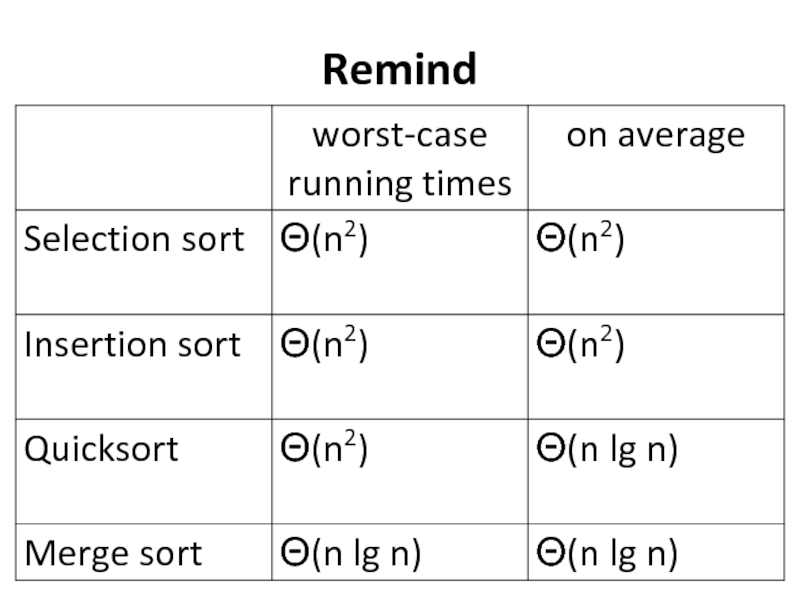
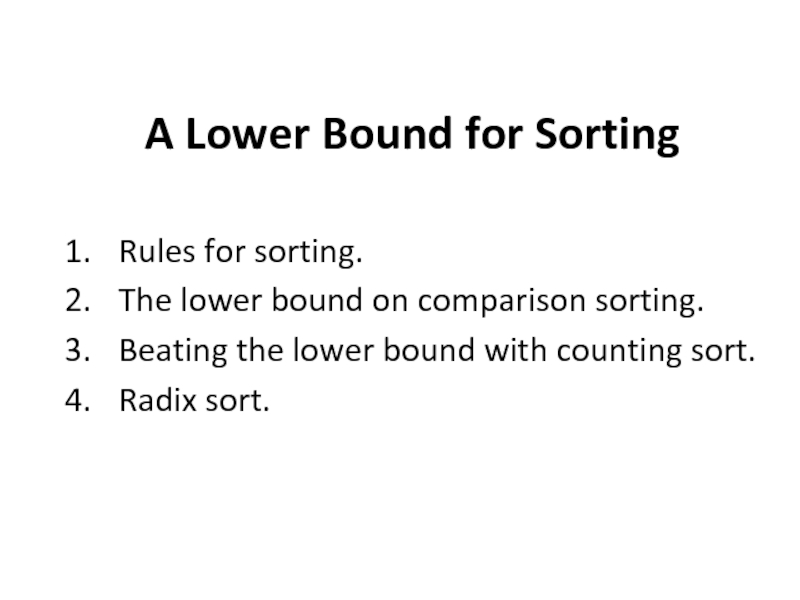
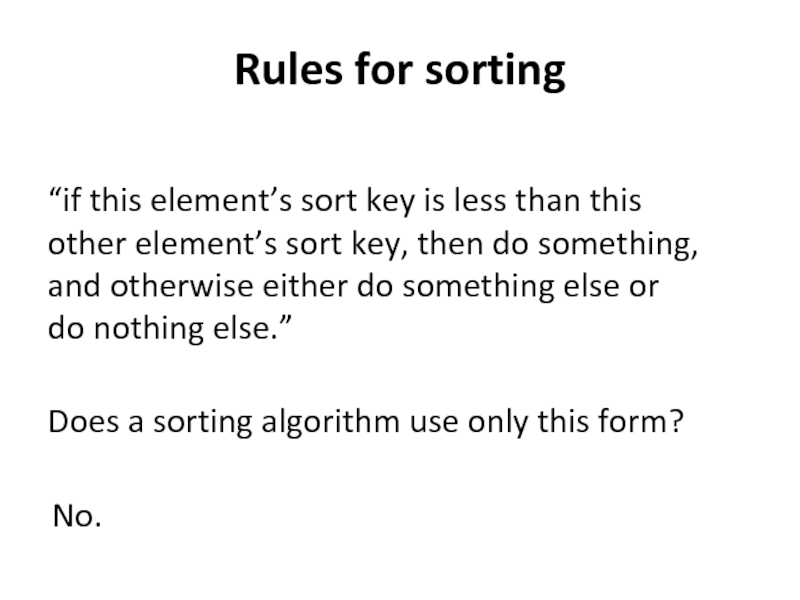
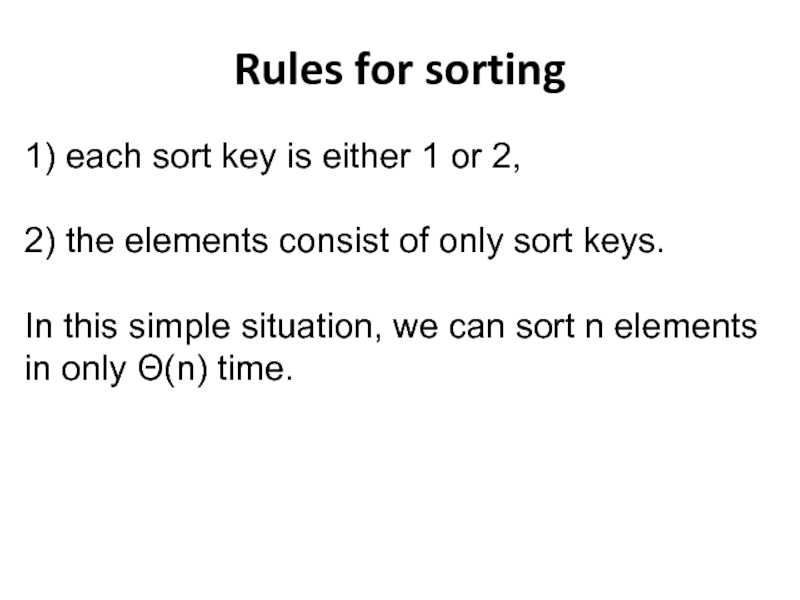
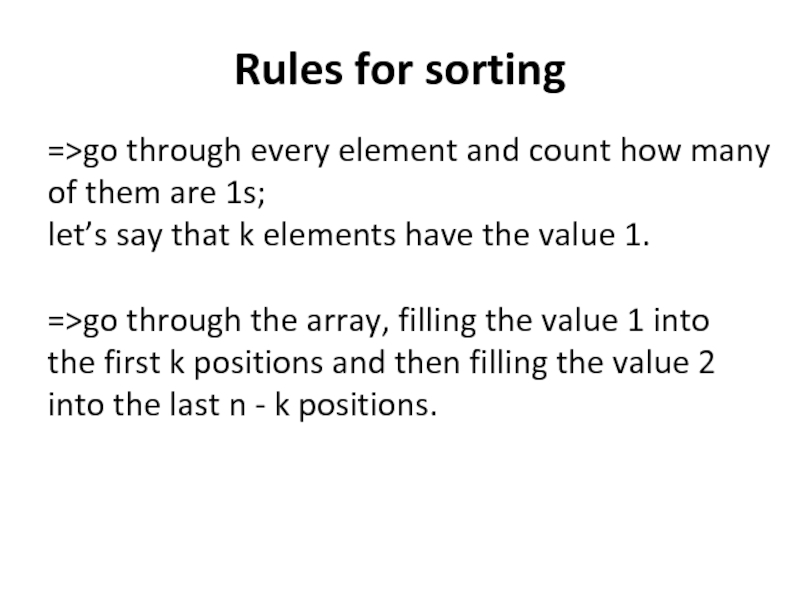
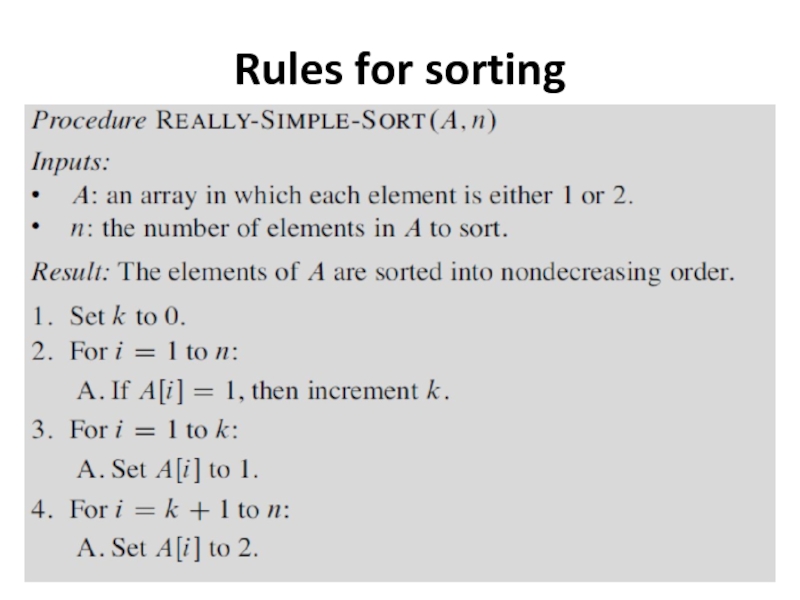
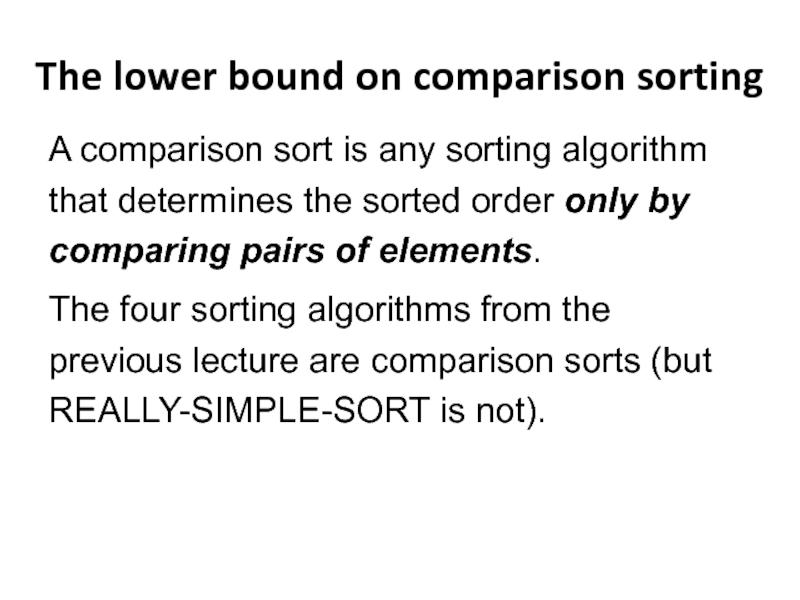
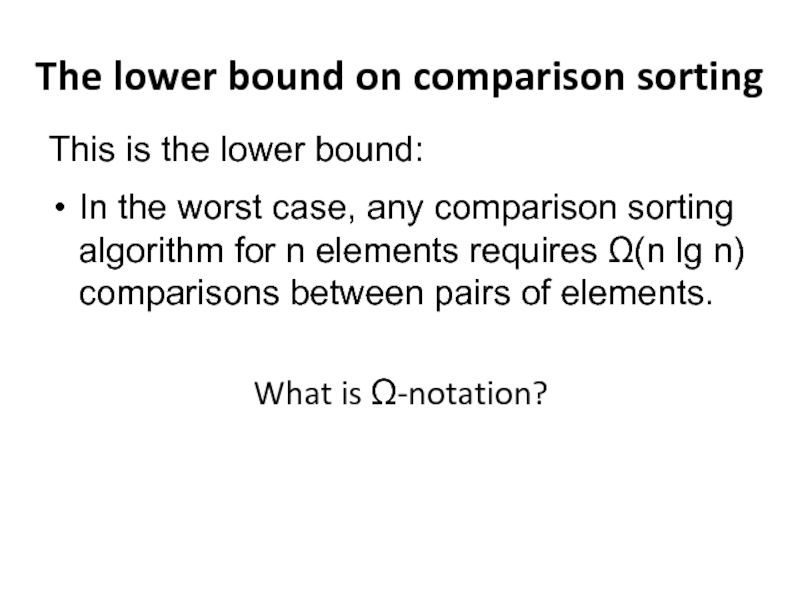
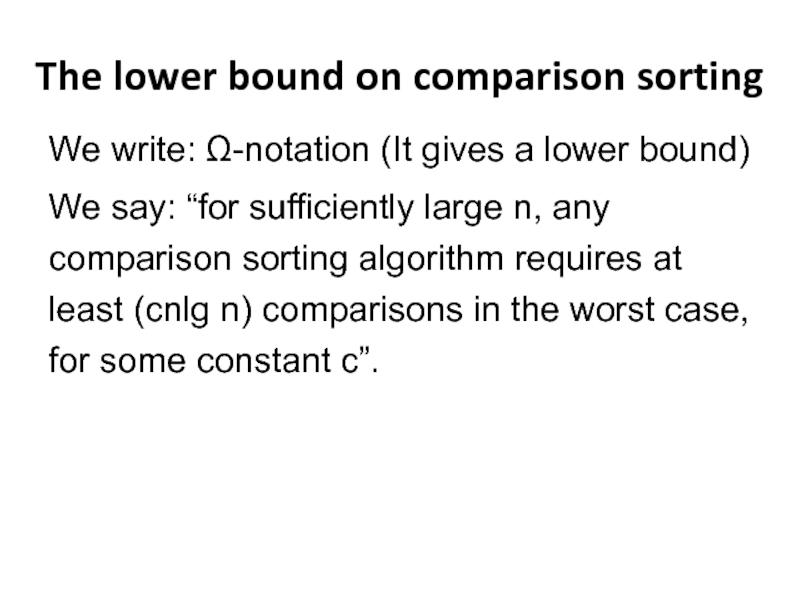
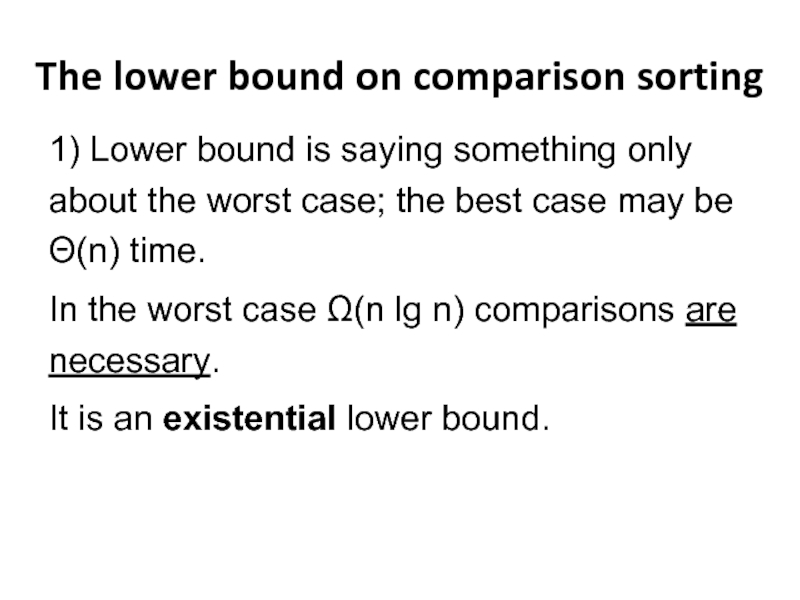

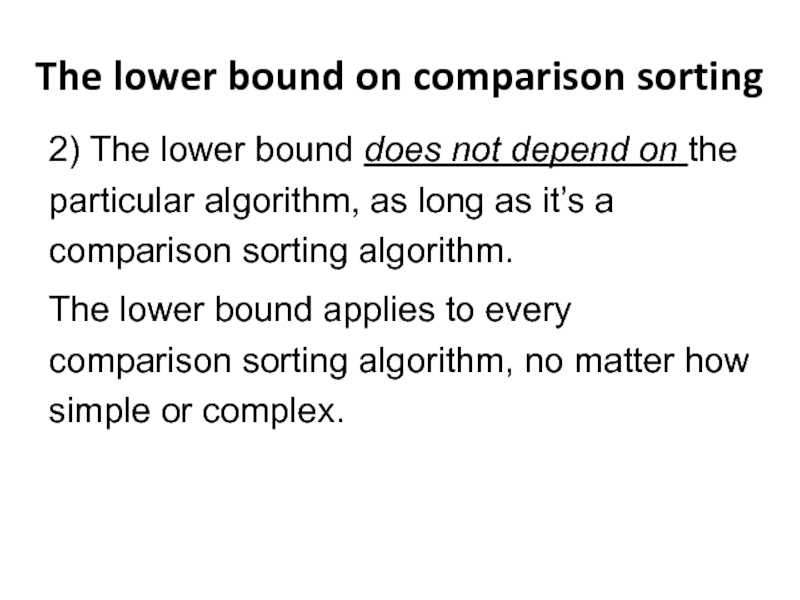
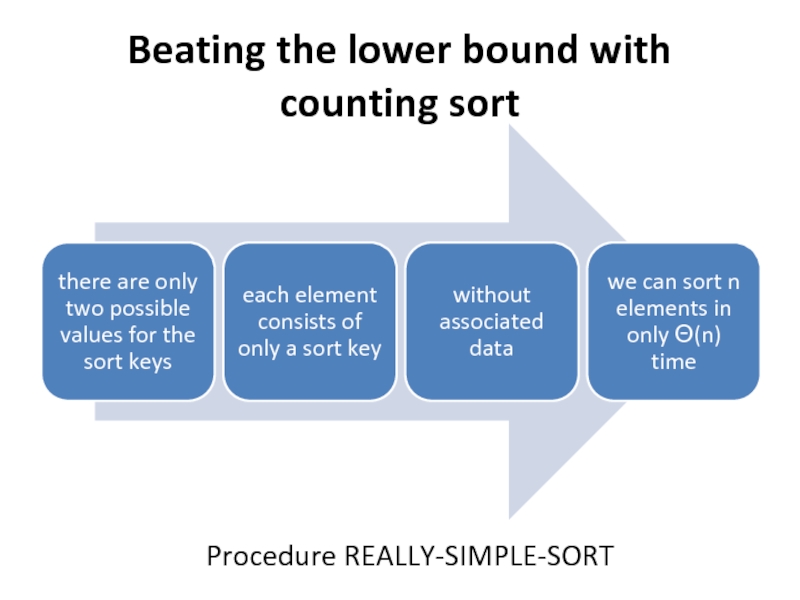
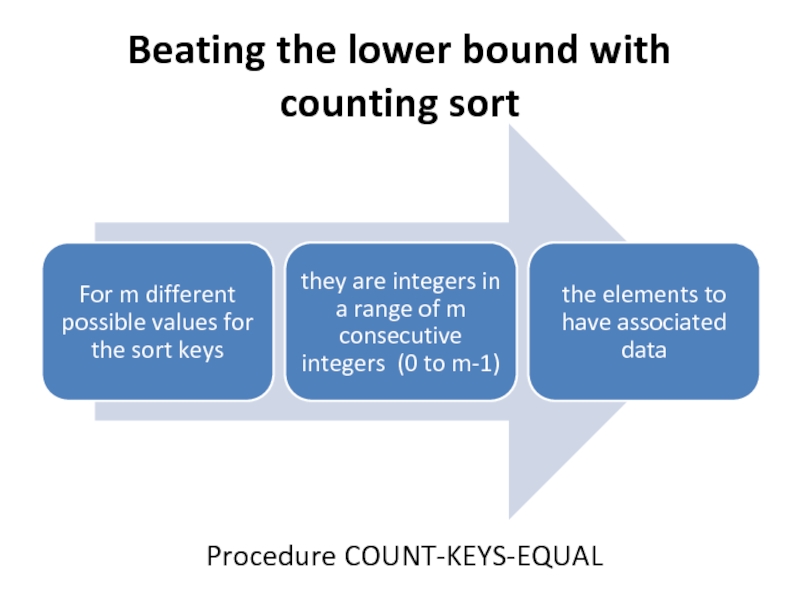
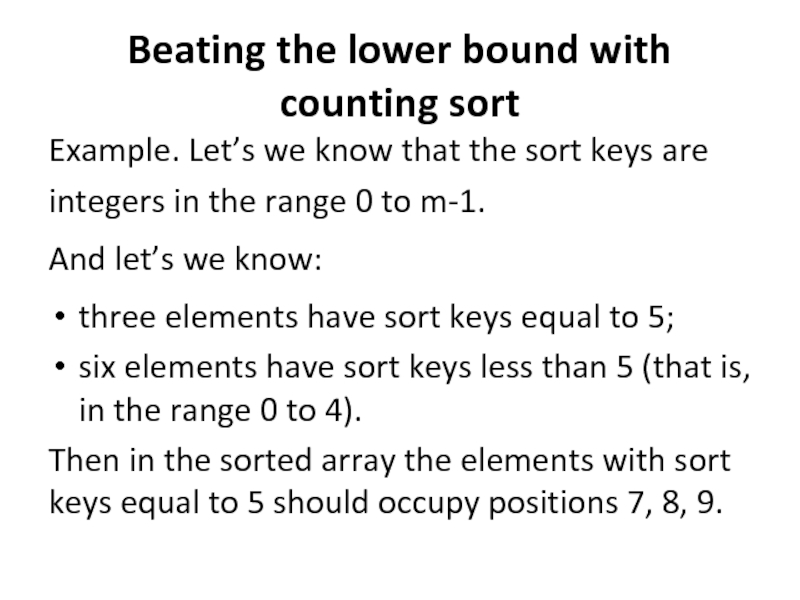
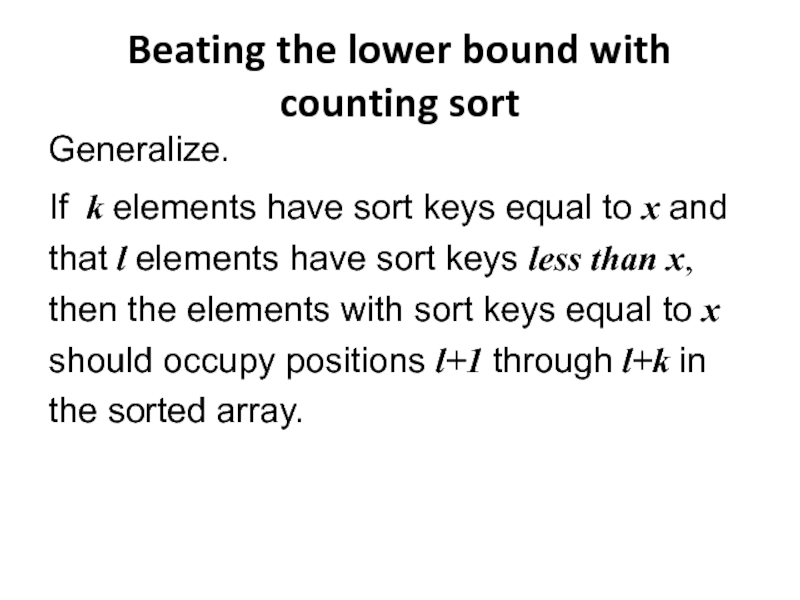
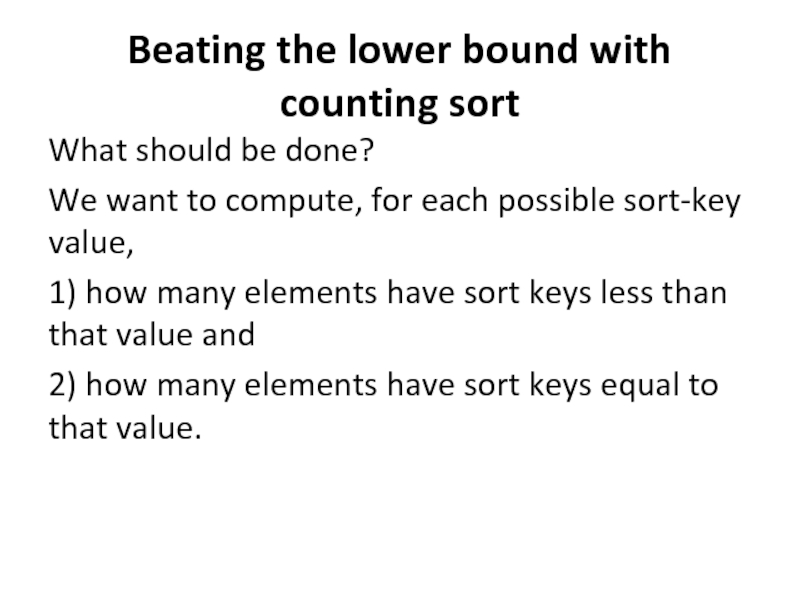
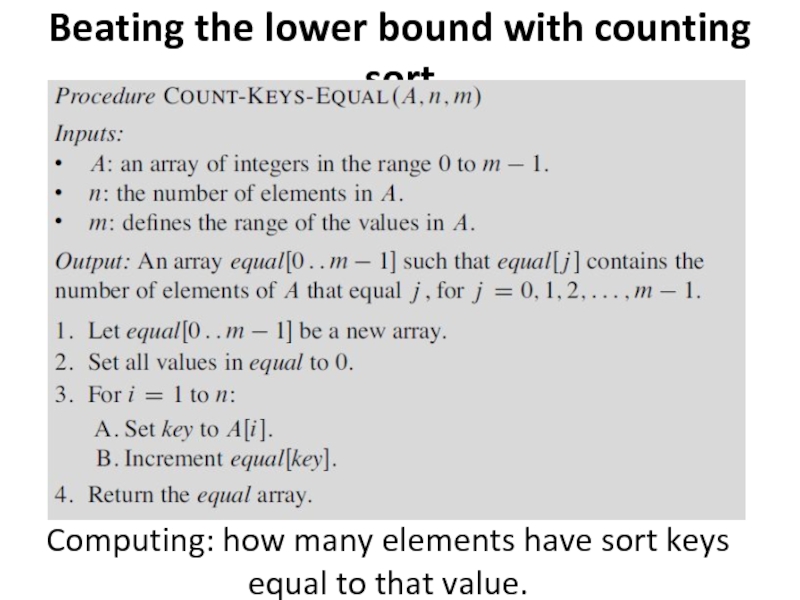
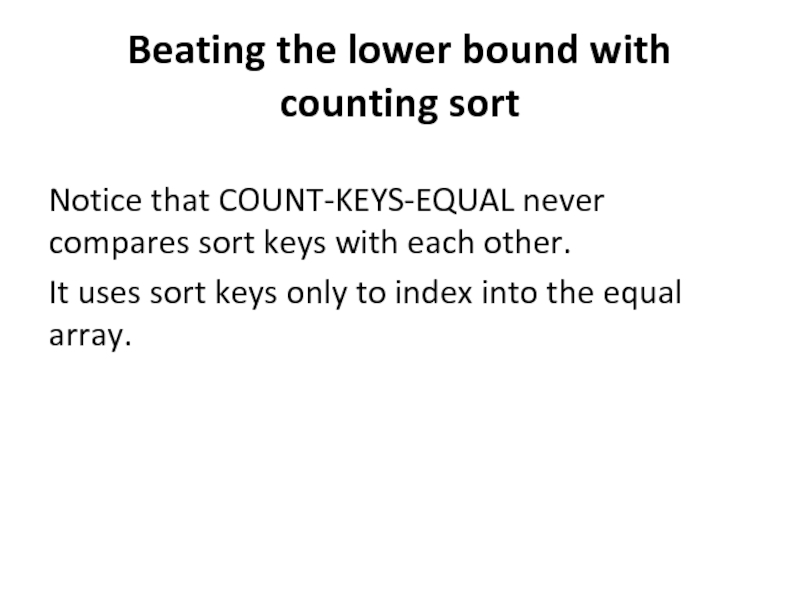
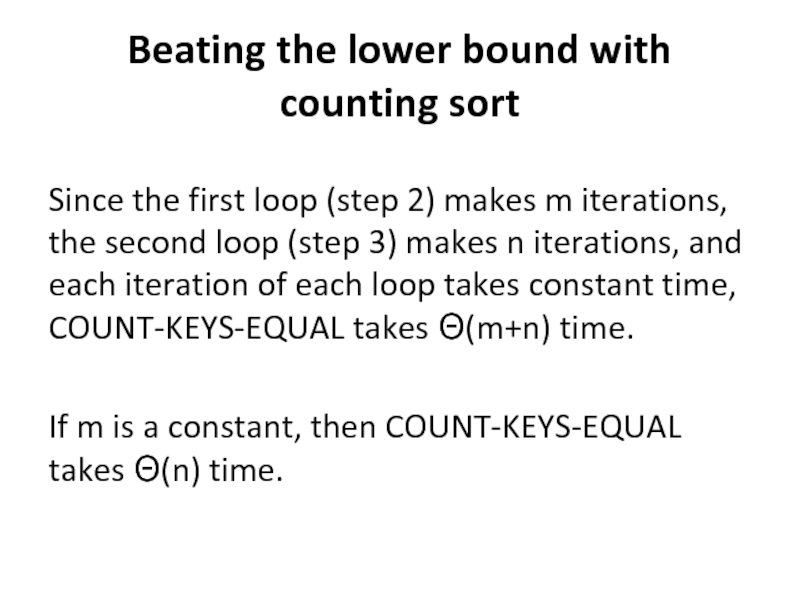
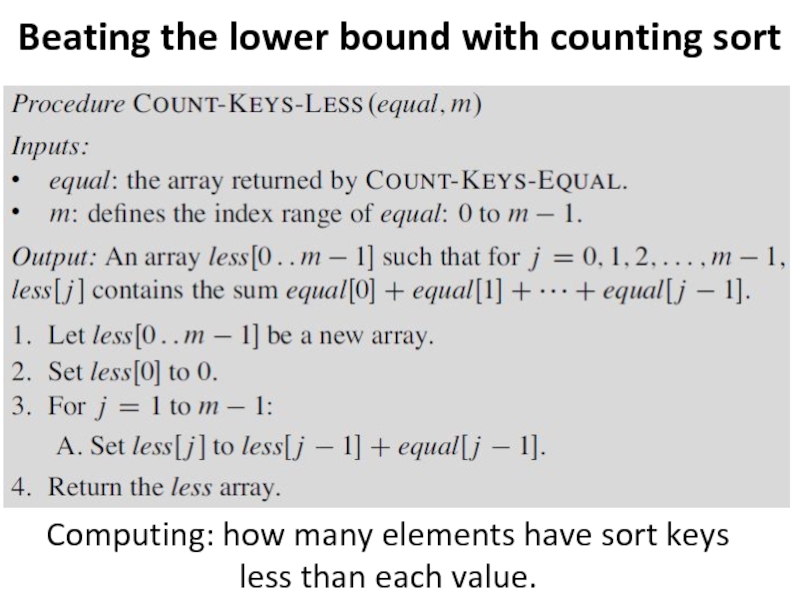

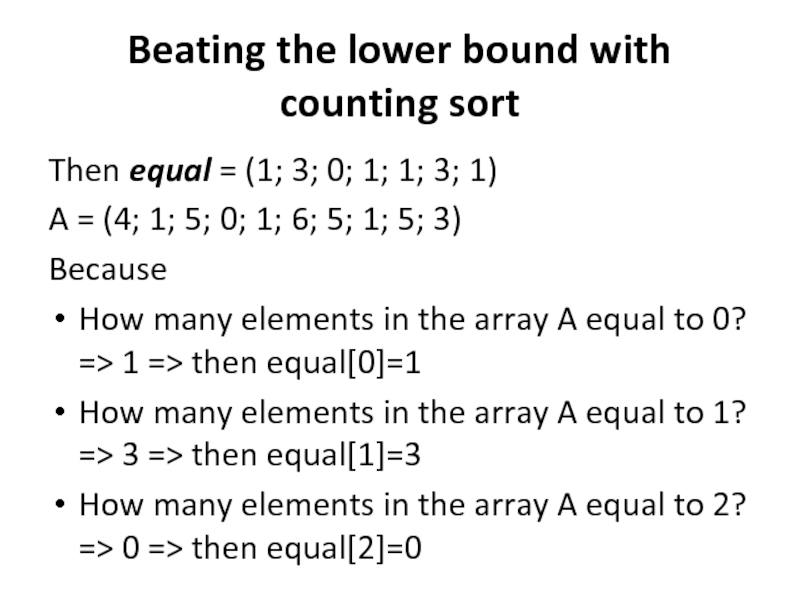
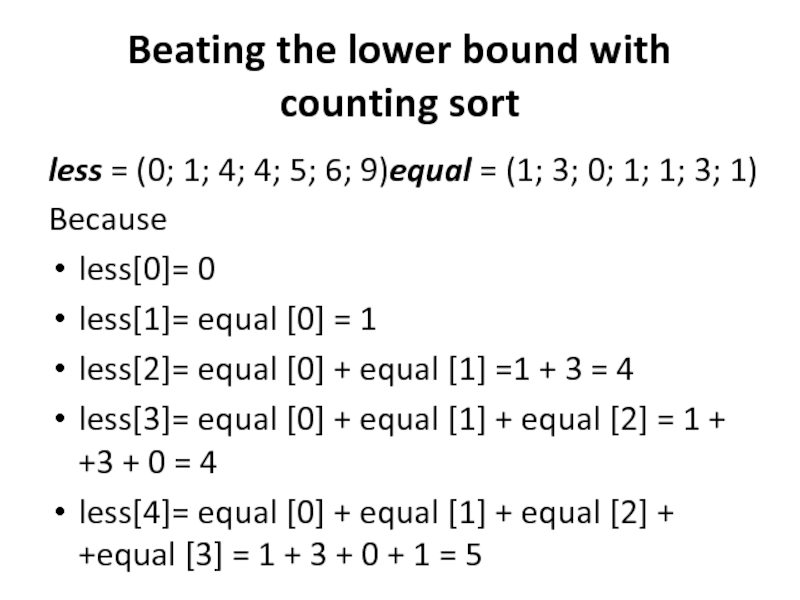
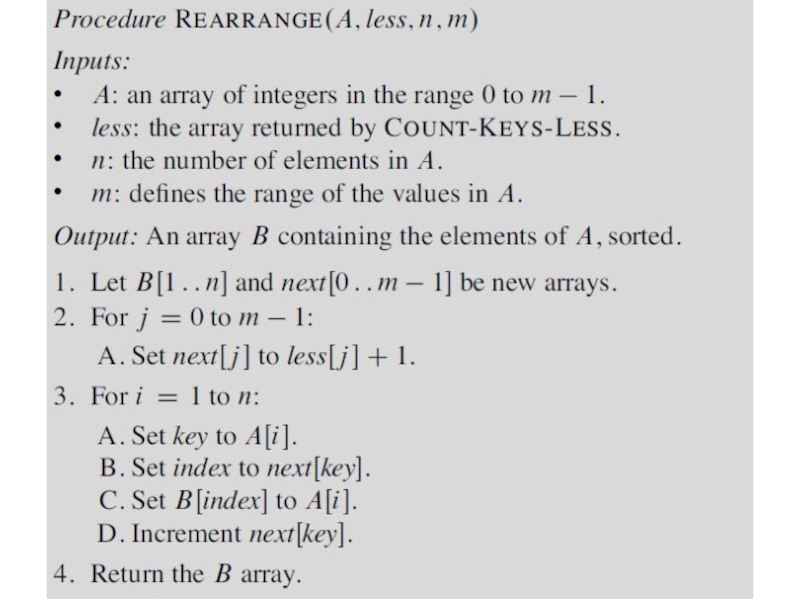
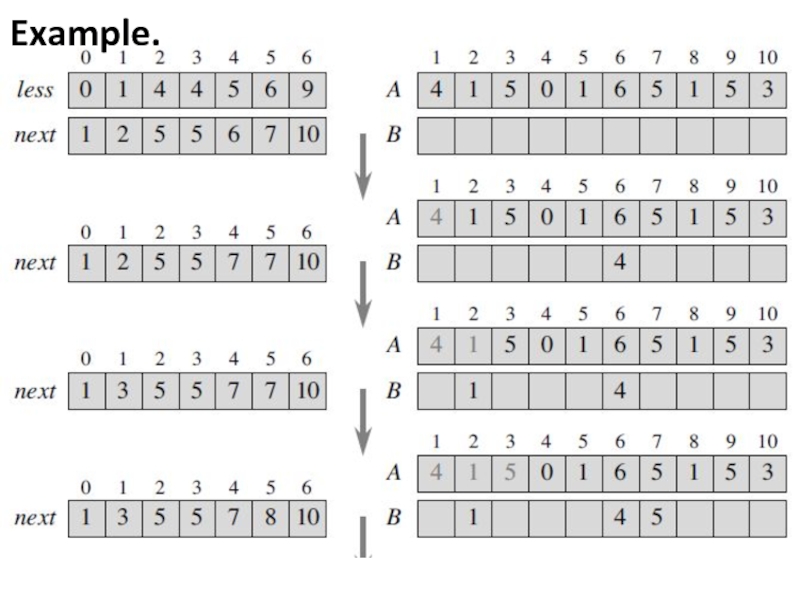
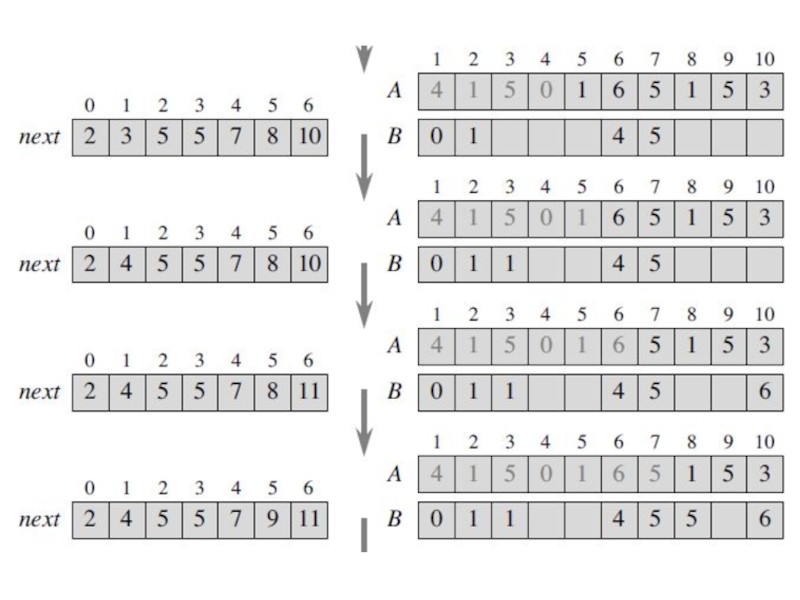
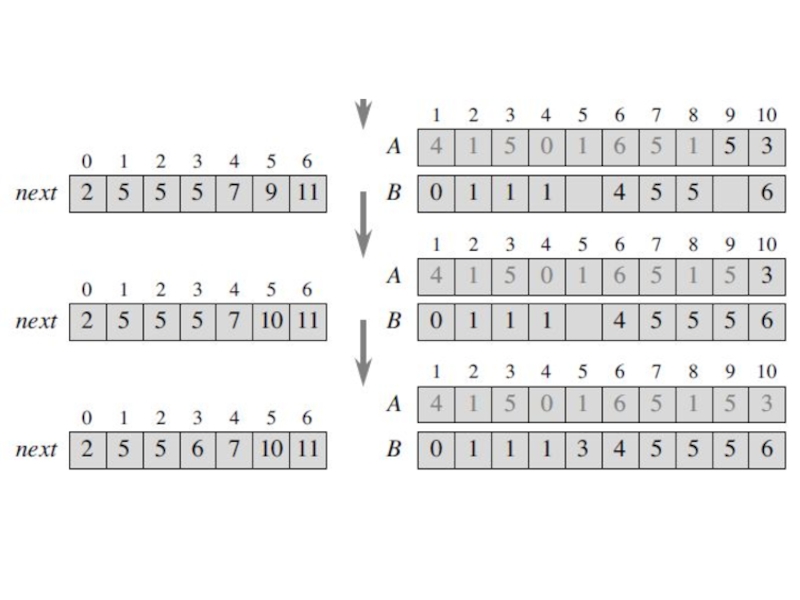
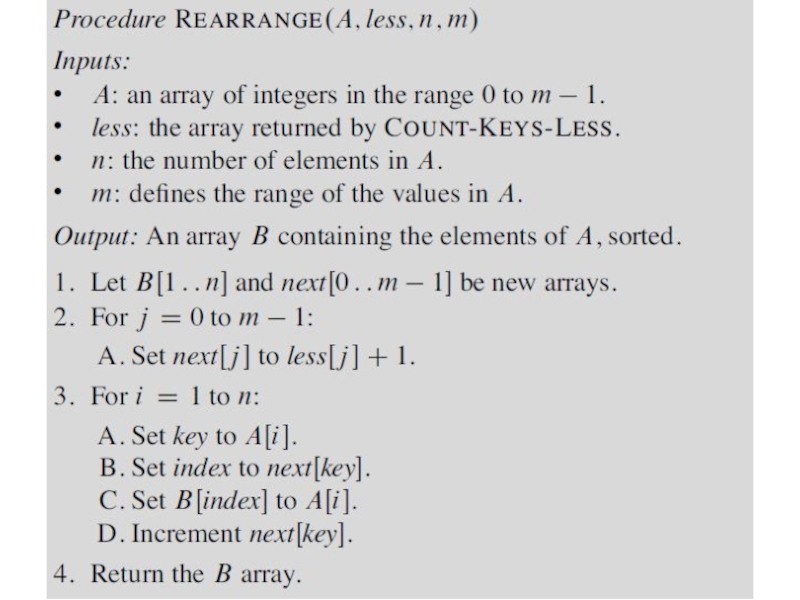
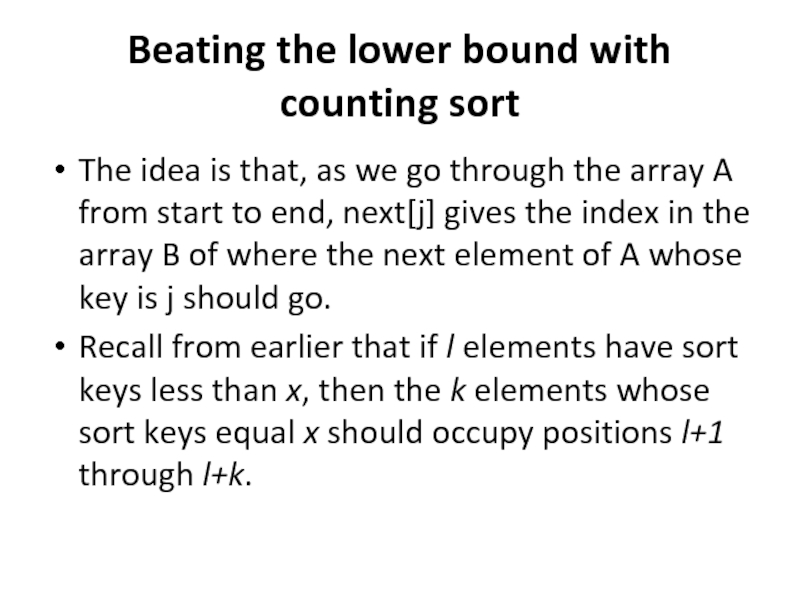
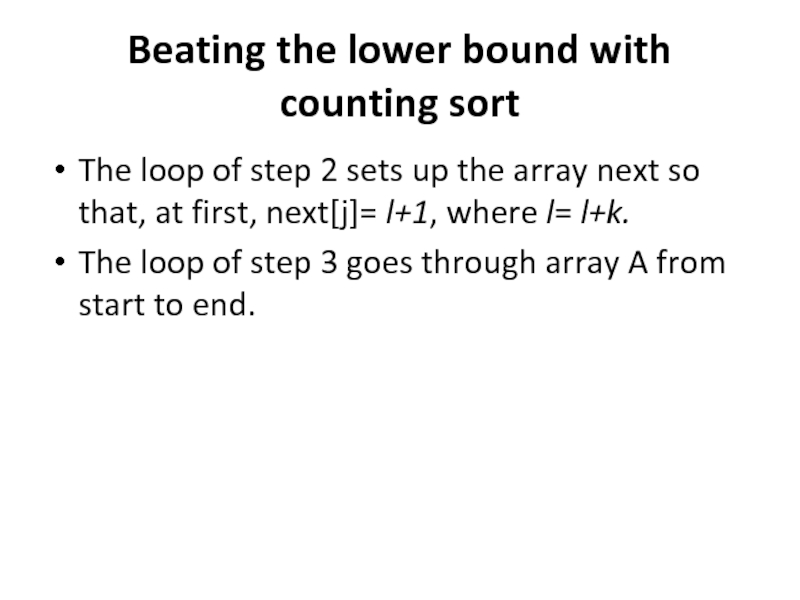
![Beating the lower bound with counting sortFor each element A[i], step 3A stores A[i] into](/img/tmb/5/425103/8eff8552cbeccc0d3377180fbd2460ab-800x.jpg)
